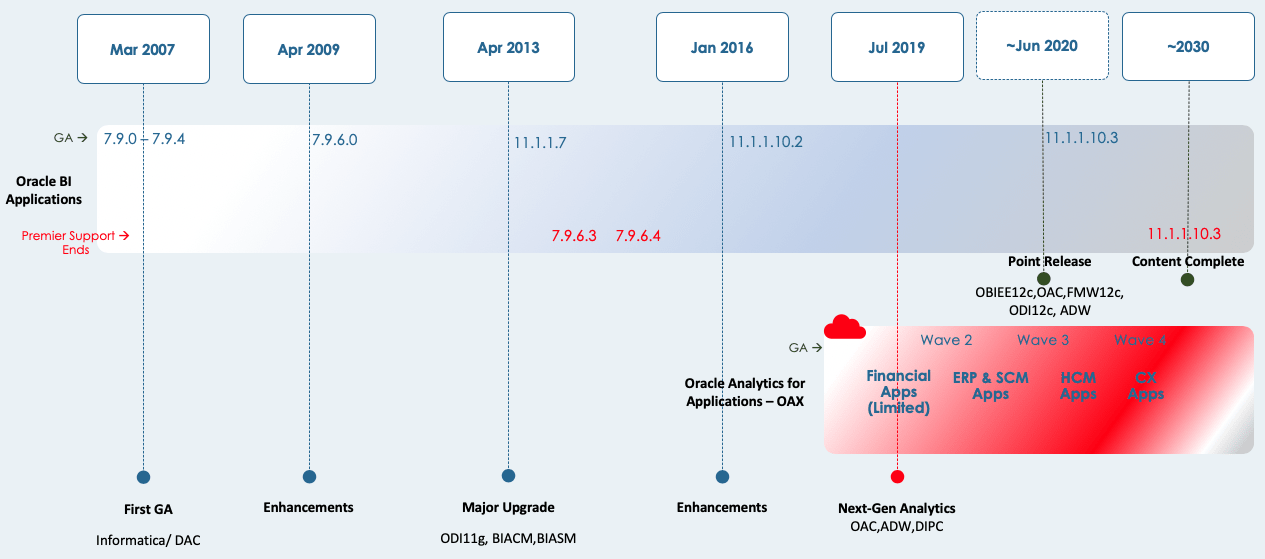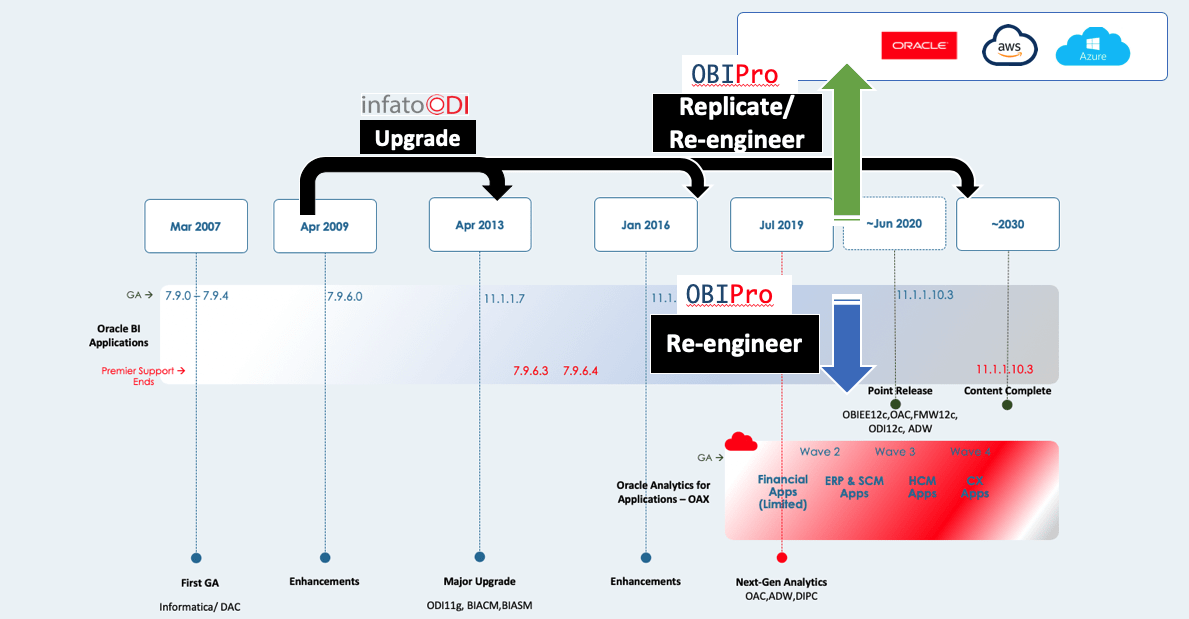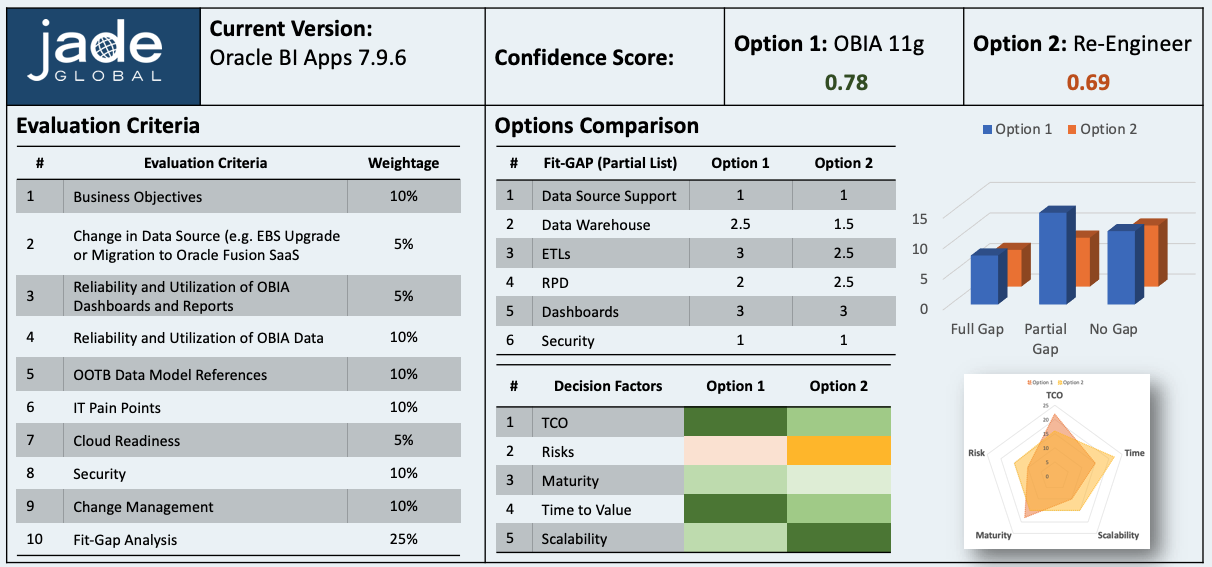This article is for you if you are one of the many Oracle customers who believe in and have invested years into Oracle BI Applications. Many enterprises using Oracle as an Enterprise Business Intelligence Platform are evaluating various options to retain the efforts already invested in Oracle BI Applications (OBIA).
Oracle Business Intelligence Applications
OBIA enables organizations to gain insights and greater value from a range of data sources, including Oracle on-premise Applications Unlimited (E-Business Suite, PeopleSoft, JD Edwards, and Siebel), Oracle SaaS Applications (HCM Cloud, ERP Cloud, SCM Cloud, and CX Cloud), and non-Oracle sources via custom integration or Oracle BI Applications Universal Adaptors. It has been quite a roller coaster ride for IT departments responsible for keeping their OBIA applications up-to-date. On the other hand, the enterprise data warehouse metrics (at least) and the dashboards delivered by OBIA have gained a lot of trust from business users. As a result, it has been quite a challenging position for IT folks to closely follow the OBIA roadmap and keep their end users happy simultaneously.

Let’s take a quick look at the overall roadmap of the OBIA. The OBIA became globally available around March 2007, and many enterprise Oracle customers started utilizing it. Over time, OBIA evolved, and Oracle delivered many versions. A major challenge was introduced when Oracle decided to decommission Informatica as its ETL tool and introduced Oracle Data Integrator (ODI) as the standard ETL platform. Upgrading Oracle BI Applications requires skills and effort. Major steps in upgrading Oracle BI Applications are porting, merging, and reconciling customizations with Oracle’s pre-configured BI semantic layer (RPD), analyses, reports, and ODI ELT customizations. There has been quite a bit of confusion about the future of OBIA, as the premier support for the latest OBIA 11.1.1.10.2 is about to end. However, the latest announcements in the Oracle Statement of Direction for OBIA clarify that the (upcoming) latest release, 11.1.1.10.3, will be the point release and will be supported at least through 2030.
On the other end (in-line with Oracle’s “cloud first” strategy), Oracle has released Oracle Analytics for Applications (OAX), specifically designed for Oracle SaaS Applications like Oracle Fusion Cloud SaaS and NetSuite. So, if you plan to migrate from on-premise Oracle ERPs like EBS, PSFT, and JDE to Oracle Fusion SaaS, it directly impacts your OBIA.
Jade Global has worked closely with our Oracle customers and helped them tackle such complex situations. We have applied the experience and knowledge gained through these projects to our proprietary tools and framework. The patent-pending tools we have created, such as InfatoODI, can accelerate the migration from Informatica to ODI while delivering a guarantee to retain the ETL logic you have implemented over the years.
We have also encountered situations where customers did not have deeper dependencies on OBIA. In these scenarios, our OBIPro (a set of assessment tools and framework) helped them expedite the migration and eliminated complete dependencies from OBIA.
Multiple decision factors will directly impact your roadmap. There are also multiple options to consider when deciding your path to upgrade or migrate from OBIA and define Enterprise BI and Analytics for your organization:
- The OBIA upgrade option will migrate you to the latest version of OBIA and let you continue utilizing the OBIA until 2030 on the latest certified Oracle platforms like Oracle Analytics Cloud (OAC), OBIEE12c, FMW 12c, Autonomous Data Warehouse (ADW), ODI12c, etc.
- The Re-Engineer/ Replicate option allows you to identify the priority OBIA objects most important for your enterprise reporting needs. Furthermore, this method allows you to select platforms (cloud or on-premise) of your preference based on your enterprise reporting and analytics strategy.
The diagram below outlines the paths involved in the OBIA upgrade option versus the Re-Engineer/Replicate option.

OBIPro has a list of predefined evaluation criteria and methods to collect metadata. In the scope state, we finalize these criteria and confirm the weightage of each criterion. The evaluation criteria include all important aspects, including business objectives, technical dependencies on OBIA, IT pain points, change management, and solution fit-gap analysis. These criteria will identify the top two options that best fit the given OBIA system landscape. Next, OBIPro will perform the fit-gap analysis between two target states compared to the current system footprint. The fit-gap analysis will cover the deeper analysis of all the layers of OBIA, including ETL/ ELT jobs, DWH tables, RPD models, and reports and dashboards by business areas. The results will then be delivered in Full Gap, Partial Gap, and No Gap score models.
Finally, to deliver the confidence score of each option, five decision factors will be compared as listed in the diagram below (TCO, Risks, Maturity, Time to Value, and Scalability) Read the blog: Things to Know if you are Considering an Upgrade to the latest Version of Oracle BI Apps and Moving to Oracle Data Integrator (ODI)

Here are customer case studies where two Jade Global customers each selected a different option when deciding their path to upgrade or migrate from OBIA:
- OBIA Upgrade Option Case Study: A Jade Global customer had over 600 custom Informatica mappings, RPD development, reports, and dashboards. We utilized the InfatoODI tool to accelerate migration from OBIA 7.9.2 to OBIA 11.1.1.10.2. The migration time was reduced by 50% compared to manually estimated migration. This was a complete Jade Global-owned project; we managed all the risks and delivered the project on fixed-price terms. Read the full story here
- Re-Engineer/ Replicate Option Case Study: This example is another Jade Global customer who had also been using the OBIA for a long time. We executed our OBIPro assessment tool to help customers decide the best-fit option for their organization. The OBIPro confidence score favored the re-engineering option, so we helped the customer migrate from OBIA to their preferred platform of choice. The ETLs were simplified and re-engineered into MS SSIS hosted in AWS cloud, and critical business metrics and KPIs were replicated into Oracle Analytics Cloud (OAC).
Feel free to reach out to Jade Global by emailing info@jadeglobal.com or filling out the Contact Us form below to understand better our offerings that can help you expedite an OBIA upgrade or migration.







